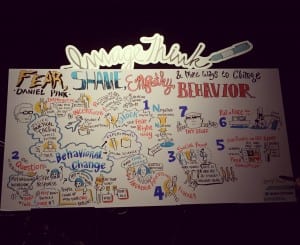
Illustration from Daniel Pink’s SXSW session: Fear, Shame, Empathy & More Ways to Change Behavior
I thought my first day “as the new kid” at SXSW would be a blast, overwhelming and out-of-this-world. It wasn’t. It was better. It was an intellectual paradise.
I came away from day one with pages of notes from sessions filled with fantastic insights from a wide range of speakers. In particular, those of author Daniel Pink.
In Mr. Pink’s session, Fear, Shame, Empathy & More Ways to Change Behavior, Daniel shared that when trying to change behavior, a goal of all great communicators, there are several ways to engage with your audience. Among his “seven principles of behavior change,” there were three insights that resonated with me personally from the session:
1. Give people a clear off-ramp.
Make action easy. He explained that context affects our behavior above all else. We often over-weigh the importance of personality and, as a result, devalue context when trying to motivate a call-to-action. As communicators, we must continue to deeply think about the context of our messages as well as the people (or demographics) we are trying to reach.
2. Don’t use fear … unless it’s in the right way.
The goal here is to enhance focus. Daniel used the example of flight attendants giving their inflight announcements. Most people don’t listen to the announcements, but when you tell them that their chances of fatal injury increases by 40% when they don’t follow instructions, ears perk up. Even more importantly, fear can’t be used a motivational tool. “Positive emotions lead to expansive views.” In other words, you can’t inspire creativity with fear (click to tweet).
3. Ask a lot of questions.
Simple enough, right? But this is a hugely overlooked strategy when trying to affect behavior. When the facts are clear, ask questions and encourage discussion. When you ask the right questions, you will get active responses. Active responses lead to active dialog, and only active dialog and the healthy exchange of ideas can affect change.
I’ll leave you with a closing thought on self-confidence from the post-session Q&A. An audience member asked Daniel if he had ever lost his self-confidence and, if so, how did he restore it? His response: instead of the peppy “self-talk” we engage in before that big pitch, try the interrogative talk. Ask yourself, “Can you do this? And if so, how?”
There’s so much more I’d like to share. But for now, I must return to the action in my fresh and comfy kicks (thanks Brad Simon for the SXSW survival guide post).
Remember, check out the latest SXSW commentary from Ketchum on our website’s social hub.


